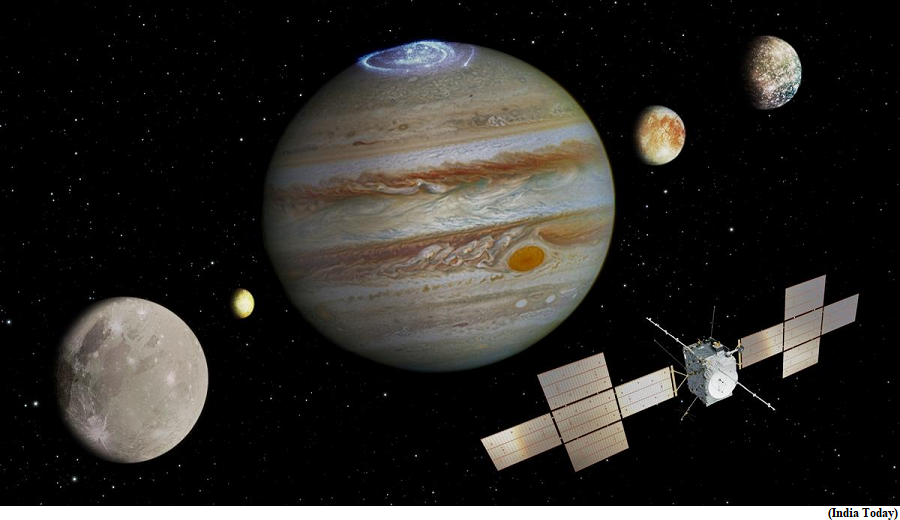Europe Juice mission (GS Paper 3, Science and Tech)

Why in news?
Details:
- The Juice will launch from Europe's spaceport French Guiana on an eight-year-long voyage to Jupiter and its moons.
- During its voyage, the spacecraft will complete fly-bys of Venus, Earth, and the Earth-Moon system to arrive at its destination in 2031.
Mission:
- The spacecraft will observe Jupiter and its three largest moons: Callisto, Europa, and, in particular, Ganymede.
- The moon’s buried oceans could tell whether life can arise in different environments across the cosmos.
- The objective is to explore the moons for habitability and to explore if it is possible to live around giants.
- The spacecraft will characterise the oceans, icy shells, compositions, surfaces, environments, and activity of Ganymede, Europa, and Callisto and the wider Jupiter system, characterising Jupiter’s atmosphere, magnetic environment, ring system, and other satellites.
- After its first arrival in the Jovian system, the spacecraft will go on to spend many months orbiting Jupiter, completing fly-bys of Europa, Ganymede, and Callisto, and finally conducting an orbital tour of Ganymede.
Instruments onboard:
- The spacecraft will be powered by 10 solar panels that will be deployed as two distinctive cross-shaped arrays. These total an area of about 85 square meters.
- Juice has been equipped with 0 state-of-the-art instruments, comprising the most powerful remote sensing, geophysical, and in situ payload complement ever flown to the outer Solar System.
- The mission has a remote sensing package that includes imaging and spectral imaging capabilities, a geophysical package that comprises a laser altimeter (GALA), and a radar sounder (RIME) for exploring the moon’s surface and subsurface.
- The in situ package contains a powerful suite of instruments to study the particle environment (PEP), a magnetometer (J-MAG), and a radio and plasma wave instrument (RPWI).
- Juice has a 2.5-meter-long High Gain Antenna to talk to Earth.
Way Forward:
- As the mission begins its journey from French Guiana it will shed more light on what are Jupiter’s ocean worlds like and why is Ganymede so unique? and could there be or ever have been life in the Jupiter system?
A beginner’s guide to the Large Hadron Collider, its functions and its future
(GS Paper 3, Science and Tech)
Why in news?
- Currently, the engineers are warming up the Large Hadron Collider (LHC), for its third season of operations beginning in May 2023.

Details:
- The Large Hadron Collider (LHC), built by the European Organization for Nuclear Research (CERN), is on the energy frontier of physics research, conducting experiments with highly energised subatomic particles.
- The LHC, is the world’s largest science experiment.
- It is a collider that accelerates two beams of particles in opposite directions and smashes them head on. These particles are hadrons.
The functioning of the LHC:
- A hadron is a subatomic particle made up of smaller particles. The LHC typically uses protons, which are made up of quarks and gluons.
- It energises the protons by accelerating them through a narrow circular pipe that is 27 km long.
How it works?
- Simply put, this pipe encircles two D-shaped magnetic fields, created by almost 9,600 magnets. Say there is a proton at the 3 o’clock position.
- It is made to move from there to the 9 o’clock position by turning on one hemisphere of magnets and turning off the other, such that the magnetic field acting on the proton causes it to move clockwise.
- Once it reaches the 9 o’clock position, the magnetic polarity is reversed by turning off the first hemisphere and turning on the second. This causes the proton to move in an anticlockwise direction, from 9 o’clock back to the 3 o’clock position.
- This way, by switching the direction of the magnetic field more and more rapidly, protons can be accelerated through the beam pipe. There are also other components to help them along and to focus the particles and keep them from hitting the pipe’s walls.
- Eventually, the protons move at 99.999999% of the speed of light. In the process they accrue a tremendous amount of energy according to the special theory of relativity.
The effects of collision:
- When two antiparallel beams of energised particles collide head on, the energy at the point of collision is equal to the sum of the energy carried by the two beams.
- Thus far, the highest centre-of-mass collision energy the LHC has achieved is 13.6 TeV (teraelectron-volts). This is less energy than what would be produced on clapping hands once.
- The feat is that the energy is packed into a volume of space the size of a proton, which makes the energy density very high.
Particle interactions:
- There is a lot of energy available, and parts of it coalesce into different subatomic particles under the guidance of the fundamental forces of nature.
- Which particle takes shape depends on the amount and flavour of energy available and which other particles are being created or destroyed around it. Some particles are created very rarely.
- If, say, a particle is created with a probability of 0.00001%, there will need to be at least 10 million collisions to observe it.
- Some particles are quite massive and need a lot of the right kind of energy to be created (this was one of the challenges of discovering the Higgs boson).
- Some particles are extremely short-lived, and the detectors studying them need to record them in a similar timeframe or be alert to proxy effects.
- The LHC’s various components are built such that scientists can tweak all these parameters to study different particle interactions.
Key findings of the LHC:
- The LHC consists of nine detectors. Located over different points on the beam pipe, they study particle interactions in different ways.
- Every year, the detectors generate 30,000 TB of data worth storing, and even more overall. Physicists pore through this data with the help of computers to identify and analyse specific patterns. This is how the ATLAS and CMS detectors helped discover the Higgs boson in 2012 and confirmed their findings in 2013.
- The LHC specialises in accelerating a beam of hadronic particles to certain specifications and delivering it. Scientists can choose to do different things with the beam. For example, they have used the LHC to energise and collide lead ions with each other and protons with lead ions.
- Using the data from all these collisions, they have tested the predictions of the Standard Model of particle physics, the reigning theory of subatomic particles; observed exotic particles like pentaquarks and tetraquarks and checked if their properties are in line with theoretical expectations; and pieced together information about extreme natural conditions, like those that existed right after the Big Bang.
What lies ahead for the LHC?
- One way forward, which is already in the works, is to improve the LHC’s luminosity (a measure of the machine’s ability to produce particle interactions of interest) by 10x by 2027 through upgrades.
- Another, more controversial idea is to build a bigger version of the LHC, based on the hypothesis that such a machine will be able to find ‘new physics’ at even higher energies.
- While both CERN and China have unveiled initial plans of bigger machines, physicists are divided on whether the billions of dollars they will cost can be used to build less-expensive experiments, including other colliders, with guaranteed instead of speculative results.
SC ruling on Agnipath scheme
(GS Paper 2, Judiciary)
Why in news?
- Recently, the Supreme Court dismissed petitions challenging the Delhi High Court judgment which upheld the Agnipath scheme for recruitment to the armed forces.
- Some of the petitioners included candidates who were shortlisted in the earlier recruitment process to Army and Air Force.

What was the plea before SC?
- Advocate Prashant Bhushan who appeared for some of these candidates told the apex court that their names appeared in a provisional list for recruitment to Air Force but the recruitment process was cancelled when Agnipath scheme was notified.
- He argued that the government must be directed to complete the old process citing the doctrine of promissory estoppel.
- He argued that there was written exam, physical test, medical exam conducted under the old recruitment process after which a provisional selection list was published with the ranks.
What is the doctrine of promissory estoppel?
- Promissory estoppel is a concept developed in contractual laws.
- A valid contract under law requires an agreement to be made with sufficient consideration.
- A claim of doctrine of promissory estoppel essentially prevents a “promisor” from backing out of an agreement on the grounds that there is no “consideration.”
- The doctrine is invoked in court by a plaintiff (the party moving court in a civil action) against the defendant to ensure execution of a contract or seek compensation for failure to perform the contract.
- In a 1981 decision in Chhaganlal Keshavalal Mehta v. Patel Narandas Haribhai, the SC lists out a checklist for when the doctrine can be applied:
- First, there must be a clear and unambiguous promise.
- Second, the plaintiff must have acted relying reasonably on that promise.
- Third, the plaintiff must have suffered a loss.
How does it relate to the Agnipath case?
- The argument invoking the doctrine essentially means that the government’s actions of putting up a shortlist etc would be a “promise” made by it.
- The other party here, the candidates acted based on that promise, they refused other jobs in CRPF, BSF etc and now must be compensated for their loss.
- However, the judges quickly refused this argument. CJI pointed out that “promissory estoppel is always subject to overarching public interest”.
- Justice PS Narasimha added that “this is not a contract matter where promissory estoppel in public law was applied, it is a public employment” and that “the question of applying this principle will not arise in this case”.




